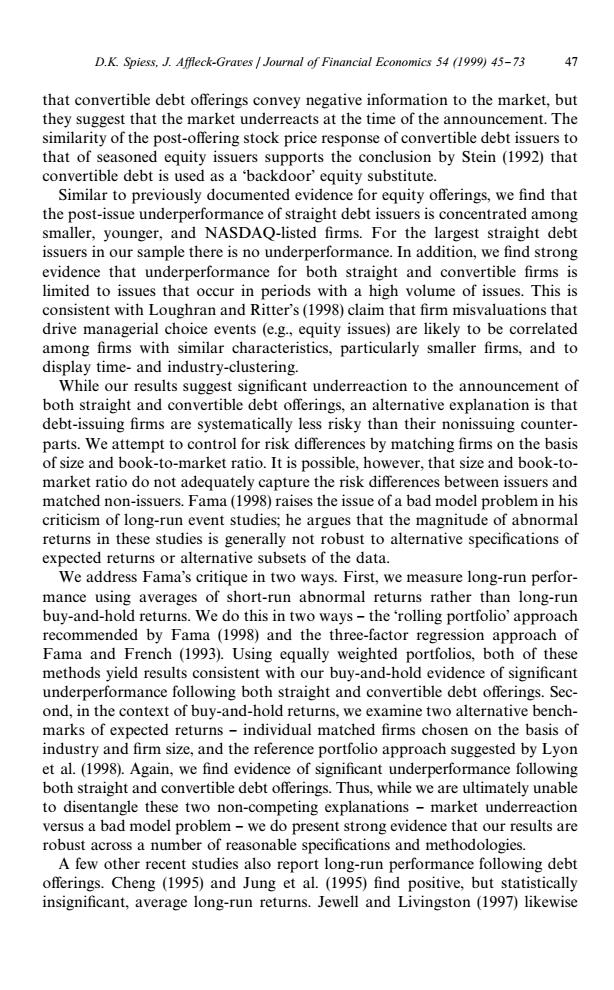正在加载图片...

D.K.Spiess,J.Affleck-Graves Journal of Financial Economics 54 (1999)45-73 47 that convertible debt offerings convey negative information to the market,but they suggest that the market underreacts at the time of the announcement.The similarity of the post-offering stock price response of convertible debt issuers to that of seasoned equity issuers supports the conclusion by Stein(1992)that convertible debt is used as a backdoor'equity substitute. Similar to previously documented evidence for equity offerings,we find that the post-issue underperformance of straight debt issuers is concentrated among smaller,younger,and NASDAQ-listed firms.For the largest straight debt issuers in our sample there is no underperformance.In addition,we find strong evidence that underperformance for both straight and convertible firms is limited to issues that occur in periods with a high volume of issues.This is consistent with Loughran and Ritter's(1998)claim that firm misvaluations that drive managerial choice events (e.g.,equity issues)are likely to be correlated among firms with similar characteristics,particularly smaller firms,and to display time-and industry-clustering. While our results suggest significant underreaction to the announcement of both straight and convertible debt offerings,an alternative explanation is that debt-issuing firms are systematically less risky than their nonissuing counter- parts.We attempt to control for risk differences by matching firms on the basis of size and book-to-market ratio.It is possible,however,that size and book-to- market ratio do not adequately capture the risk differences between issuers and matched non-issuers.Fama(1998)raises the issue of a bad model problem in his criticism of long-run event studies;he argues that the magnitude of abnormal returns in these studies is generally not robust to alternative specifications of expected returns or alternative subsets of the data. We address Fama's critique in two ways.First,we measure long-run perfor- mance using averages of short-run abnormal returns rather than long-run buy-and-hold returns.We do this in two ways-the 'rolling portfolio'approach recommended by Fama (1998)and the three-factor regression approach of Fama and French (1993).Using equally weighted portfolios,both of these methods yield results consistent with our buy-and-hold evidence of significant underperformance following both straight and convertible debt offerings.Sec- ond,in the context of buy-and-hold returns,we examine two alternative bench- marks of expected returns-individual matched firms chosen on the basis of industry and firm size,and the reference portfolio approach suggested by Lyon et al.(1998).Again,we find evidence of significant underperformance following both straight and convertible debt offerings.Thus,while we are ultimately unable to disentangle these two non-competing explanations-market underreaction versus a bad model problem-we do present strong evidence that our results are robust across a number of reasonable specifications and methodologies. A few other recent studies also report long-run performance following debt offerings.Cheng (1995)and Jung et al.(1995)find positive,but statistically insignificant,average long-run returns.Jewell and Livingston (1997)likewisethat convertible debt o!erings convey negative information to the market, but they suggest that the market underreacts at the time of the announcement. The similarity of the post-o!ering stock price response of convertible debt issuers to that of seasoned equity issuers supports the conclusion by Stein (1992) that convertible debt is used as a &backdoor' equity substitute. Similar to previously documented evidence for equity o!erings, we "nd that the post-issue underperformance of straight debt issuers is concentrated among smaller, younger, and NASDAQ-listed "rms. For the largest straight debt issuers in our sample there is no underperformance. In addition, we "nd strong evidence that underperformance for both straight and convertible "rms is limited to issues that occur in periods with a high volume of issues. This is consistent with Loughran and Ritter's (1998) claim that "rm misvaluations that drive managerial choice events (e.g., equity issues) are likely to be correlated among "rms with similar characteristics, particularly smaller "rms, and to display time- and industry-clustering. While our results suggest signi"cant underreaction to the announcement of both straight and convertible debt o!erings, an alternative explanation is that debt-issuing "rms are systematically less risky than their nonissuing counterparts. We attempt to control for risk di!erences by matching "rms on the basis of size and book-to-market ratio. It is possible, however, that size and book-tomarket ratio do not adequately capture the risk di!erences between issuers and matched non-issuers. Fama (1998) raises the issue of a bad model problem in his criticism of long-run event studies; he argues that the magnitude of abnormal returns in these studies is generally not robust to alternative speci"cations of expected returns or alternative subsets of the data. We address Fama's critique in two ways. First, we measure long-run performance using averages of short-run abnormal returns rather than long-run buy-and-hold returns. We do this in two ways } the &rolling portfolio' approach recommended by Fama (1998) and the three-factor regression approach of Fama and French (1993). Using equally weighted portfolios, both of these methods yield results consistent with our buy-and-hold evidence of signi"cant underperformance following both straight and convertible debt o!erings. Second, in the context of buy-and-hold returns, we examine two alternative benchmarks of expected returns } individual matched "rms chosen on the basis of industry and "rm size, and the reference portfolio approach suggested by Lyon et al. (1998). Again, we "nd evidence of signi"cant underperformance following both straight and convertible debt o!erings. Thus, while we are ultimately unable to disentangle these two non-competing explanations } market underreaction versus a bad model problem } we do present strong evidence that our results are robust across a number of reasonable speci"cations and methodologies. A few other recent studies also report long-run performance following debt o!erings. Cheng (1995) and Jung et al. (1995) "nd positive, but statistically insigni"cant, average long-run returns. Jewell and Livingston (1997) likewise D.K. Spiess, J. A{eck-Graves / Journal of Financial Economics 54 (1999) 45}73 47